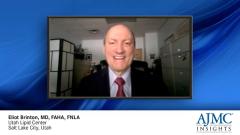
Unmet Needs in Treatment of HoFH
Medical experts discuss the unmet needs surrounding homozygous FH.
Episodes in this series

Eliot Brinton, MD: With all the tools we have for homozygous familial hypercholesterolemia [HoFH], there are patients who spend way too much of their time with an LDL [low-density lipoprotein] way above 70 [mg/dL]. And it may be just 100 [mg/dL] is way too high for them, it could be 200 [mg/dL], even with all these treatments that we talked about. There is an unmet need, and the unmet need is for further LDL lowering, and the question of how we’re going to get there. Certainly, we could try to block apoB synthesis. But it turns out that’s not a good idea because it tends to cause the problems that I described with lomitapide. What you’re doing there is you’re blocking the assembly of apoB-100 or apoB-48 into a particle, the chylomicron or the LDL particle. And it basically seems to have those same drawbacks. Blocking apoB, which would be fairly easy to do and it was done back in the day with another drug that’s no longer with us, is probably not a good target, so what are we going to do? Maybe more drugs for MTP [microsomal triglyceride transfer protein], which is the drug that is blocked by lomitapide. That’s the drug that is responsible for assembly of these particles.
Looking at how to address the unmet needs, another possibility would be to try to block ANGPTL3 [angiopoietin-like 3]. Evanicumab is a very successful agent. Could we somehow double up on that? It’s possible. Although, evanicumab blocks it very nicely, so I’m not sure that another agent with that target would necessarily work. We are at a loss at the moment for what we will do, except I will come back to a key point, and that is being aggressive in diagnosing the problem. Look at those funny cutaneous xanthomas, look at that LDL above say 400 [mg/dL], and be very quick to jump on treatment, or early referral, or both. Referral to a board-certified lipidologist, or even not board-certified, to somebody who focuses on lipids and has the tools at their disposal, that’s very helpful. Don’t sit on these patients. Don’t say, “Well, come back in a year, and we’ll see if diet helps your LDL.” It’s not going to happen. Quick diagnosis, early diagnosis, early referral, and then fairly expeditiously going through the 4 standard treatments for LDL lowering, and then arriving at those 3 specialty treatments, and doing our best with all 3 of them. There are going to be reasons why 1 of the 3 may be out of the question for a given patient. But we do our best with those 3.
Then the last treatment, and I mention this last because it’s our last resort, would be a liver transplant. A liver transplant is you’re stuck with a transplanted liver. Those have a limited half-life. You’re taking all the antitransplant drugs. It can be done. I have a patient who had HoFH, and he got end-stage heart failure because he had such horrendous atherosclerosis and recurrent myiasis. This was back before we had our current treatments. He needed a heart transplant to live, so they did a heart and liver transplant. You can do liver transplant. Conceivably maybe doing a knock-in, doing gene treatment, gene editing to put in the LDL receptor. That’s something that’s out there as a possibility. There is some fallback position. But realistically we’re aggressively using these 3 treatments that I focused on, with perhaps a minor assist from the others. Then we want to follow the patient invasively or noninvasively according to the patient’s circumstances. But CT angiogram [CTA] is useful; of course, a standard coronary angiogram is useful, as is cardiac ultrasound to look at aortic valve stenosis and the gradients.
There are various ways we can follow these patients and see exactly how big the problem is. There’s aortic arch stenosis, which can be followed by the CTA. We have ways to follow and we need to follow the patients to see what’s happening and their disease state, along with whatever the maximal treatment for their LDL is. And then of course we try to strictly avoid other factors like cigarette smoking and diabetes. We want to make sure that’s prevented, or well managed if it happens to be present. Any of these other factors are important. We have a challenge here, but it’s a challenge that’s doable. You can also get into genetic testing, which really isn’t needed for clinical management, and genetic counseling, which is certainly reasonable. But that’s another discussion all together and peripheral to what we’ve focused on here, which is the diagnosis and management of that very high-risk patient with HoFH.
Seth Baum, MD: We recently have gotten access to evinacumab, the most recent therapeutic for HoFH. It’s very effective, a 50% reduction in spite of even null/null LDL receptors. So one might say, we hit the jackpot and we don’t need to do anything else. We have hit the jackpot, but we have to remember the start point of the LDL in these patients. There remains a huge unmet need. We need more therapeutics that work independently of LDL receptor activity. And we need, as I mentioned several times, greater access to the therapies we have. But we also need greater identification of these patients. The unmet need is we’re not identifying these people early enough in life or ever, frankly. We need to be cascade screening our patients. We need doctors to screen these patients at the age of 2, the high-risk patients with [high] LDLs. Frankly, I think we need universal screening for FH and LDLs at a very young age, at 2, let’s say. We have a lot of unmet needs. We need more education for clinicians, we need education of lay people regarding FH. We have a lot of work yet to do.
Erin Michos, MD, MHS: I think despite how severely elevated their cholesterol is, many patients with HoFH are diagnosed too late, when clinically significant atherosclerotic cardiovascular disease is already present when they’re in their youth and adolescent years. And they’re suboptimally treated despite the fact that we have substantial advances in lipid-lowering therapy. There continues to be a significant disparity. When you look globally, there are disparities between patients who live in high-income countries compared to those who live in low-income countries. There’s a need to update our global policies to ensure access to more patients globally. I think we need to do a better job of pediatric cholesterol screening. Even though it was recently recommended by the American Academy of Pediatrics to measure a lipid test in individuals of age 2 if they have a family history of early onset atherosclerotic cardiovascular disease, studies have suggested that recommendation has had suboptimal uptake, and not many young children get the screening until it’s clinically obvious they have this disorder. [We should] even have more routine screening of lipids at pediatric age, ages 9 to 11, to identify individuals who have HeFH [heterozygous familial hypercholesterolemia].
Transcript edited for clarity.
Newsletter
Stay ahead of policy, cost, and value—subscribe to AJMC for expert insights at the intersection of clinical care and health economics.










































